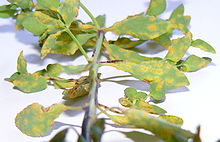| Uromyces | |
|---|---|

| |
| Uromyces pisi-sativi on leaves of cypress spurge (Euphorbia cyparissias) | |
| Scientific classification | |
| Domain: | Eukaryota |
| Kingdom: | Fungi |
| Division: | Basidiomycota |
| Class: | Pucciniomycetes |
| Order: | Pucciniales |
| Family: | Pucciniaceae |
| Genus: | Uromyces (Link) Unger (1833)[1] |
| Type species | |
| Uredo appendiculata Pers. (1796)
| |
| Synonyms[2] | |
| |
Uromyces is a genus of rust fungi in the family Pucciniaceae. The genus was described by Franz Unger in his 1833 work Die Exantheme der Pflanzen. They have a worldwide distribution but large occurrences happen in North America and Europe.[2]
The genus is the second-largest plant pathogenic rust genus, which is responsible for various plant affecting diseases, and it has major effects on both agricultural and non-agricultural plants. The genus is generally characterized by its unicellular teliospores (thick-walled resting spores) that help to characterize it and distinguish it from another important and large rust genus, Puccinia.[3]
The Uromyces fungal species have been recorded on various host plants belonging to a wide range of the families, including Asteraceae, Euphorbiaceae, Fabaceae, Liliaceae, Loranthaceae, and Poaceae. Family Loranthaceae is listed to be the most affected by the fungus.[3]
Species[edit]
As of 2023 August 22[update], the GBIF lists up to 1,048 species,[2] while Species Fungorum lists about 1,239 species (with many former species).[4] The Encyclopedia of Life lists 969 species.[5]
Selected species in the genus Uromyces include:
- Uromyces apiosporus
- Uromyces appendiculatus
- Uromyces betae - beet rust
- Uromyces beticola - bean rust
- Uromyces ciceris-arietini - chickpea rust
- Uromyces dianthi carnation rust
- Uromyces elegans
- Uromyces euphorbiae
- Uromyces graminis
- Uromyces inconspicuus
- Uromyces medicaginis
- Uromyces musae
- Uromyces oblongus
- Uromyces pisi-sativi - pea rust
- Uromyces straitus - alfalfa or lucerne rust
- Uromyces trifolii-repentis - clover rust
- Uromyces vignae - cowpea rust
References[edit]
- ^ Unger F. (1833). Die Exantheme der Pflanzen und einige mit diesen verwandte Krankheiten der Gewächse : pathogenetisch und nosographisch dargestellt (in German). p. 277.
- ^ a b c "Uromyces (Link) Unger, 1833". www.gbif.org. Retrieved 22 August 2022.
- ^ a b Gautam, Ajay Kumar; Avasthi, Shubhi; Verma, Rajnish Kumar; Sushma; Niranjan, Mekala; Devadatha, Bandarupalli; Jayawardena, Ruvishika S.; Suwannarach, Nakarin; Karunarathna, Samantha C. (14 June 2022). "A Global Overview of Diversity and Phylogeny of the Rust Genus Uromyces". J. Fungi (Basel). 8 (6): 633. doi:10.3390/jof8060633. PMC 9224716. PMID 35736116.
- ^ "Species Fungorum - Search Page - Uromyces". www.speciesfungorum.org. Retrieved 22 August 2023.
- ^ "Uromyces - Encyclopedia of Life". eol.org. Retrieved 22 August 2023.
External links[edit]
- Species Profile - Gladiolus Rust (Uromyces transversalis), National Invasive Species Information Center, United States National Agricultural Library. Lists general information and resources for Gladiolus Rust.
Well, that’s interesting to know that Psilotum nudum are known as whisk ferns. Psilotum nudum is the commoner species of the two. While the P. flaccidum is a rare species and is found in the tropical islands. Both the species are usually epiphytic in habit and grow upon tree ferns. These species may also be terrestrial and grow in humus or in the crevices of the rocks.
View the detailed Guide of Psilotum nudum: Detailed Study Of Psilotum Nudum (Whisk Fern), Classification, Anatomy, Reproduction